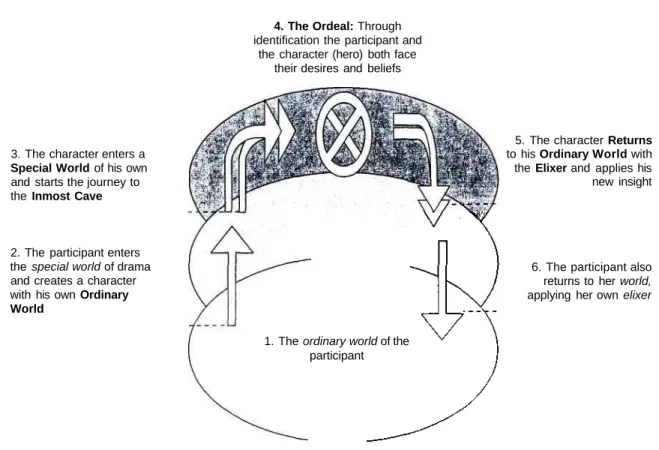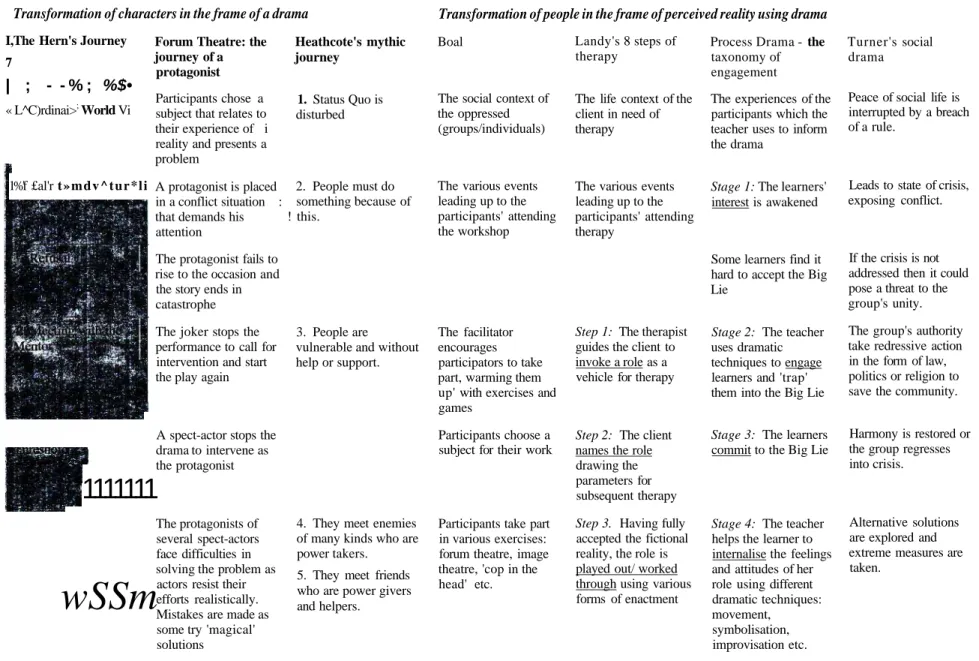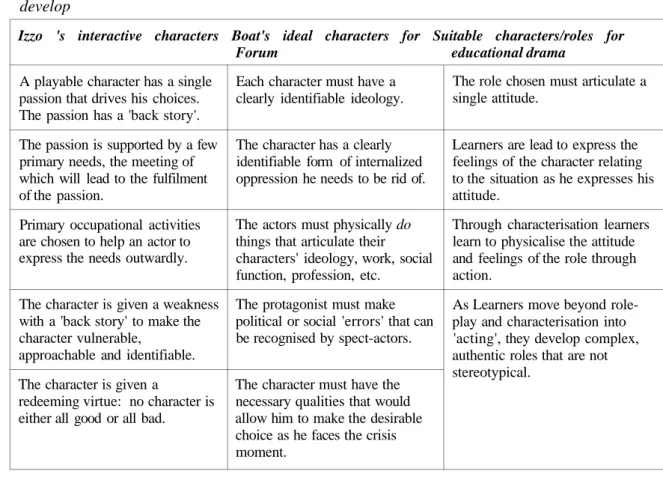For example, it can help organize apparent chaos and understand the complexity of life. The choice of this specific myth is explained at the end of the thesis in the Postscript.
THE CALL TO ADVENTURE
Introduction
THE RED SHOES
Research Focus and Questions
What role can value clarification play in the creation and development of fictional characters multifaceted enough to be compared to 'real' selves. These chapters form part 1, which deals with the theoretical basis for using value clarification as a link between dramatic character creation and self-awareness.
Definition of Terms in Context of the Study
The term dramatic character will be used to refer to people in the fictional context of the drama. She can then undergo personal growth by reflecting on how that character reacts within the fictional context of the improvised drama.
Theoretical Framework
- Frame
By framing a particular section of a variable and contingent network, it is possible to study what the frame encloses in terms of its relationship to the frame. The term perceived refers to the way each person views reality through a network of assumptions.
The only option is to compare frames and choose different frames that may better suit the specific context (Hall, 2002).
- The Importance of the Study for South Africa
- Why Drama?
- Schematic Layout of the Argument
Additionally, the drama can be used to test changes in the character's belief system and the consequences of those changes. From the drama, they will observe the events in the drama and think about them as the characters they created.
Into a World of Wonder Dramatic character creation
Chapters 2, 3 and 4, part one, focus on the first three sub-problems of the research, as outlined above in l.l. In the theory-based chapters (2, 3 and 4), the argument revolves around the relationship between drama and everyday life, and exploiting the distance between them so that one can learn about the latter through the former.
Approaching the Inmost Cave
The Road Back Analysis
The Resurrection A Longitudinal Study
Mirror Mirror on the Wall
Theoretical Foundation
THE JOURNEY BEGINS
Drama and self-Awareness
Key Concepts and Methodology: The Spect-Actor .1 Theatre of the Oppressed
The term 'rainbow of desire' refers to the concretization of desires and conflicting emotions within the individual. It is the distance between the self in the present and the imagined self of the future.
Critical Analysis
However, there are some difficulties that arise from the nature of the South African context. The reason for this is that Boal's theory does not provide an objective point of view from which to judge an individual's 'head cops'.
Robert Landy
The story as the context of the role becomes the second important dramatic framework through which we understand everyday life. Exploring options is the next step in a process called acting out or working through a role.
INTO A WORLD OF WONDER
Dramatic Character creation and Values
Gary Izzo
The order and simplification of life within the tcmenos contributes to the enjoyment of the game (Izzo, 1997: 12). Rules allow the participants to act freely because they are within the parameters of the game. Fulfillment of the passion will bring final happiness to the character, although fulfillment never takes place in performance, as it will eliminate the character's motivation.
These motives and values are determined by the character's point of view in relation to the chosen theme, subject and event of the drama. If the primary needs are met, it leads directly to the fulfillment of the passion.
Christopher Vogler
For Vogler, the achievement of the passion is paramount precisely because it will bring closure to the hero's journey. It is this collective unconscious that is the source of the archetypes and events that make up the Hero's Journey. His search for the ultimate structure of myth relates to Campbell's description of the stages of the hero's journey.
Along with achieving the goal, healing the flaw allows the hero to grow. The hero is still unaware of the problems in his world that cause instability.

APPROACHING THE INMOST CAVE
Characters and Self-Awareness
Introduction
In the educational function of drama, the relationship between frame and distance becomes insightful again. It may even mean taking the participants completely out of the drama and into the frame of perceived reality in order to reflect on the drama as themselves. I therefore begin again with an analysis of the relationship between art and nature as understood by educational drama practitioners (Section 4.2).
The subsequent section (4.4) focuses on the dramatic medium/method of the process - the people and the fictional context used to facilitate the communication of the learning objectives (the play for the learner). Finally, in section 4.5, the method of educational process drama as a way of facilitating learning about values will be critically analyzed in relation to the relationship.
The Relationship between Art and Nature: Mutual Mirroring
Don Handelman (1998) argues that ritual (like drama) is representative of the social order of which it is a product. This relationship between the concrete and specific context of the participants and the universal, or recurring patterns, is what produces new insights, evaluations and learning outcomes. It is the commentary and critical analysis of the conflict where the learning takes place.
Participation cannot be expected unless the content and form of the workshop captures their interest. This raises the question: how suitable is the content and form of the proposed workshop for the proposed target group?
Learning objectives: The Play for the Teacher
What impact does the learners' context have on their ability to engage with this content? The formation of a personal identity is one of the most important developmental tasks of adolescents (Louw Papalia and Wendkos Olds, 1995). Louw writes that, in the moral development of the adolescent and the simultaneous development of identity, it is a natural tendency for him to try and externalize his own values and evaluate them critically.
It also points to the influence of the individual's context on her ability to achieve success in the task of identity formation. These steps will be more clearly shown in the planning and evaluation of the practical process of the second part.
Strategies and Activities: The Play for the Learner
It is a very important part of the process, because the participants shape the drama themselves. The teacher, on the other hand, takes on the role of the one who needs guidance from the class. The choice of the events that will form the focus of the drama is left to the participants.
Such reflection is of the kind that occurs within the drama rather than outside it. In this way, the meaning of the symbol is more specific and special for the participants who.
Critical Analysis
In terms of the fictional framework, it was shown how Heathcote has used a mythic journey that can be compared to Vogler's Hero's Journey. Another pattern, one that can be considered secondary, is that of the type of character that makes an ideal hero. This dramaturgical nature of the learner-centered process can be further analyzed in terms of two characteristics of complex systems, viz.
What is the relationship between these individual journeys and the group's journey as a community?. Students are guided to express the character's feelings in relation to the situation when he expresses his attitude.

Practical Application
THE ORDEAL
Putting Theory to Practice
Introduction
As mentioned before, the focus of this particular practical process is the personal growth of the individual participants and their characters, while the shared growth that may occur is secondary. The question that remains after examining the theoretical basis for the recurring structure is a practical one: If the Hero's Journey explains the relationship between fiction and perceived reality from the perspective of personal growth through value clarification, how is the relationship interpreted so practically that young people can learn from it and experience such growth. This information is not mentioned to prove that the group was multicultural because the working definition of 'multicultural' implies that all young South Africans are multicultural by virtue of the many cultural influences on each individual (p. 16).
Furthermore, although the group had some dramatic experiences, of the 19 participants who continued to the end, only six such exposures at Y2Kids lasted more than six months. Before proceeding with the description of the process itself, it is necessary to provide some general information about the research methodology and the materials that describe the description, as well as about the initial planning process.
Research Method and Materials
These observations and reflections will form the basis for the analytical description of the process in the next chapter. These reflections and observations should also be planned by the teacher-director with the research in mind.
Planning
In the story, use educational drama strategies and techniques to immerse students in the Big Lie while building trust (Heathcote, pp. 128-130). Together with the theoretical suggestions, I drew up an ideal plan reflected in the first column of Table 5.1 (p. l 56). Finally, I decided that the whole process would be run like a LARP, but using educational drama strategies and techniques, developing stories and characters as we went along.
In planning each session, there was one more guiding principle throughout the process that requires attention. Where appropriate, the narrative will be supplemented with other research materials, but these will be of greater importance in the next chapter where the process is analyzed and critically evaluated.
PIPP
Chronological account
The only difference was that the group had more influence on the creation of the world and the characters they identified with. Participants are told the goal of the day: fleshing out the bones of the characters. This was the plan because I wanted to challenge students who hadn't yet figured out their character's passions (e.g. the alcoholic head of security).
The scenes are performed one after the other. o the scene proceeds without interruption,. o the scene is repeated, this time the facilitator stops the scene to ask questions or make suggestions about the performance. spacing/grouping/movement), o other participants are invited. A picture of a space station with ships approaching it is drawn on the board.
M'as problem, some said, was that they weren't given a chance to answer others. because one person will start talking and then they won't pay attention. I started saying "stop" like a peacekeeper after one person had said their piece and then asked the others who had their hands up to respond. They can't talk about how the story should go, using the Hero's Journey as a guide and then acting in the story.
Therefore, 1 must learn to not only let them go, but stop the drama, draw others' attention to them, and then use them. It might be helpful to start next week with an analysis of our story about the Hero's Journey, then ask them how they think the story should end given the stages of the journey, and then ask write a final episode.
